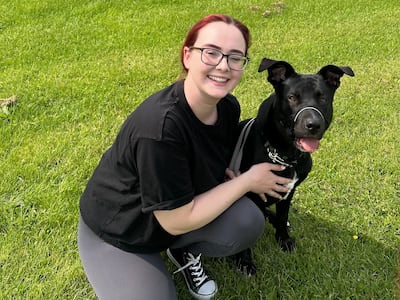When Aileen Candon’s mother died and her world turned upside down, the Dublin woman’s black Labrador helped her grieve. A year after the death of her beloved mother, in 2020, her pet Tara also died.
While the 56-year-old says she had no aspirations to get a new dog, one September morning – while volunteering at Dogs Aid Sanctuary in Dublin – she had a change of heart. While she didn’t know it at the time, of course, it was a decision that would play a role in helping her get through the sudden loss of her sister Ger nine short months later.
“I got Adi in September 2022, and I had no intention of taking a dog,” says Candon. “Even though it was 2021 when Tara passed, it was still very raw,” she says. “The minute I saw her, the whole thing changed. And I said, ‘yeah, okay, I’m ready. I want her’, and I adopted Adi.”
Candon, who is retired, says both Tara and Adi helped support her through the loss of her mother and sister respectively. Not only did her canine companions give her a reason to “bother getting up in the morning”, but she says they also helped fill the void by providing her with a deeper sense of connection.
RM Block
“Like I did with Tara, I still had to walk Adi every day when Ger died. I’d exercise her, there was playtime. And no matter how bad things were, she’d do something funny and you’d still laugh. You’d laugh and cry, she was just brilliant,” says Candon, who adopted the goldador when she weighed only 2kg.
“She’d know when I was sad, and she’d come up on the couch beside me, or on to the bed beside me, and snuggle in. The comfort that gives, in comparison to say, a counsellor... it’s huge. I can’t explain it. But it certainly helped me through an awful time. To lose your sister is traumatic, but definitely Adi helped through a really really bad time.”
According to Suzi Walsh, expert dog behaviourist and trainer, when a dog notices their human caregiver is mentally unwell, they can develop a sudden onset of separation anxiety and become very physically attached. “The dogs usually come up and they just want to be with their person,” says Walsh. “They just want to sit by them, put their head by them, have that close physical contact with their person. They want to be specifically touching them in some kind of way.”
The extra love and attention Candon received from her canine friend made her less inclined to ruminate in her thoughts. Grieving the recent loss of her sister would have been different had she not had Adi, she says. “You’d have too much time to think,” she admits. “You don’t have as much time to think with a dog. I don’t know if that’s a good or bad thing, but it’s my way of coping.

“I still think about Ger every day and rethink what happened, but having Adi makes it more bearable,” adds Candon who will be running a fundraising event for Dogs Aid Sanctuary this September.
While scientific research has repeatedly shown the psychological benefits of human-dog interactions, other studies focusing on the physical benefits of being a dog owner continue to gain prominence. A study by the British Medical Journal found strong evidence to suggest people who own dogs are more physically active than non-dog owners.
This rings true for Kildare native 27-year-old Fiona Leamy. She says she gets out at least five times a day since adopting a nine-month-old Staffy cross from the Dublin Society for the Prevention of Cruelty to Animals (DSPCA) last Christmas. “During Covid, I think in 2021, just after lockdown, I started a new job, and it was work from home. So that was very much roll out of the bed at five to nine in the morning and sit all day. I’d take my lunch in my sittingroom, sitting down. I literally didn’t go out. I maybe went out in the evening for like half an hour to go to the shops. I was not active whatsoever.”

Leamy, who is based in Wicklow, named her pup Charlie and says she now has an obligation to get out regularly, which she says has positively impacted her physical health. “We go out five, six times a day. We’re in a duplex, so we don’t have a garden, so Charlie is brought out for a minimum 10 minutes, maximum an hour, depending on the weather and the time of the day. Sometimes, he’ll go out just to use the loo, and sometimes we’ll go for a good walk to get his energy out of him.”

According to a recent study published in the British Journal of Sports Medicine, taking 10,000 steps a day lowers the risk of cardiovascular disease (CVD) for people who are desk-bound. “Looking at my steps for example on my watch, the difference from this time last year [before adopting Charlie], I was maybe hitting 1,500-2,000 steps a day and that was at a max,” says Leamy “Unless we were going for a walk [me and my partner]. But now I hit 10,000 at least, and if we go any longer, it’s 15,000-20,000 steps a day so Charlie’s helping me reach the minimum that I should be doing.”
- Sign up for push alerts and have the best news, analysis and comment delivered directly to your phone
- Join The Irish Times on WhatsApp and stay up to date
- Listen to our Inside Politics podcast for the best political chat and analysis




















